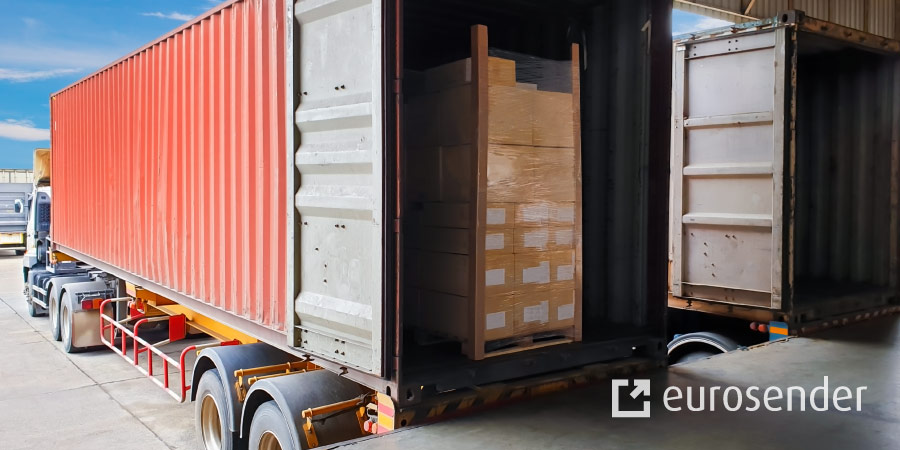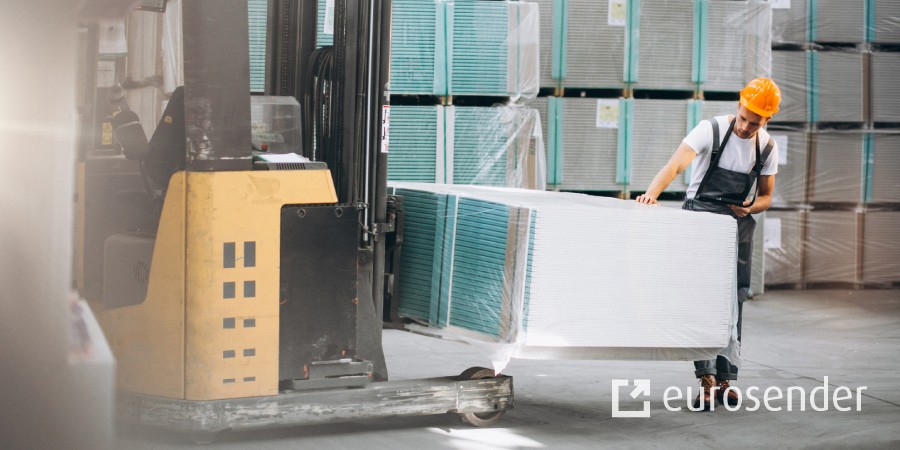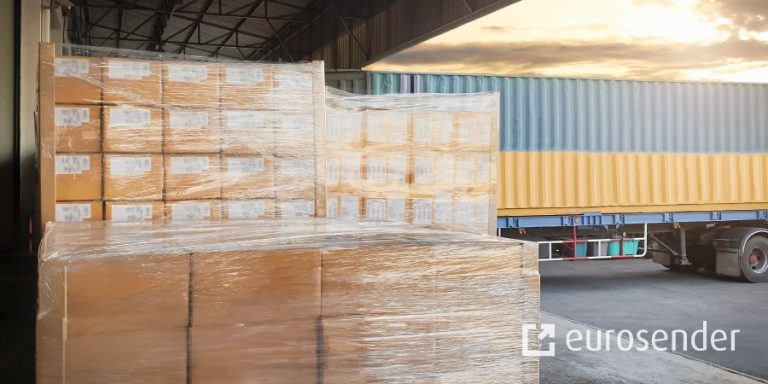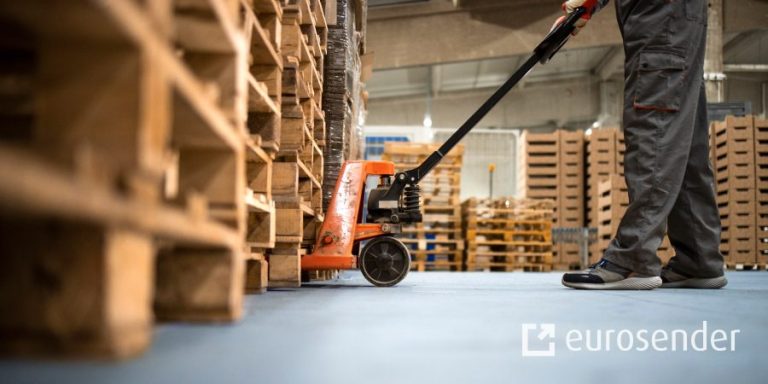8 Strategies to Prevent Cargo Damage
TL;DR
- Damaged cargo leads to financial losses and reputational harm, making prevention crucial.
- Common causes include physical damage, wet damage, reefer issues, contamination, and infestation.
- Key strategies: use suitable packaging, label correctly, follow proper pallet techniques, and ensure even weight distribution during loading.
- Consider reliable logistics partners like Eurosender for safe delivery and reduced handling risks.
Damaged cargo generates not only financial losses but also reputation damage and customer satisfaction decrease. In this blog, we will explain the common causes and types of cargo damage. By the end, you will understand why it is important to minimise cargo damage with 8 strategies you can use to prevent the risk of freight damage.
Create an account for free!
What is cargo damage?
Cargo may be considered damaged when it is received by the recipient in a condition that is worse than when it was despatched by the sender. In most cases, this leads to product and/or financial losses. If you book your delivery with Eurosender, we offer free assistance in submitting a claim to the carrier for damaged cargo.
Why is it important to minimise cargo or freight damage?
No matter how careful you are, accidents can unfortunately sometimes happen in logistics. Here we list some reasons why it’s so important to minimise cargo damage as much as possible:
- Insurance. The most noticeable loss when dealing with cargo or freight damage is that, in most cases, the insurance doesn’t cover the value of the material lost. But the financial aspect is not the only loss associated with cargo and freight damage.
- Time. Replacing the damaged cargo implies additional time that the company needs to dedicate, which increases the total cost.
- Credibility. When the cargo is not delivered or arrives damaged to your customer, your credibility is at stake. And that can detract/impede setting up a long-term relationship with the customer. As a result, the company’s sales and market positioning may drop.
What are the most common causes and types of cargo damage?
There are five main causes and types of cargo damage:
- Physical damage – This is when cargo is damaged due to dropping, breakage, improper packing, or bumps during transit etc.
- Wet damage – As the name suggests, this is when cargo is damaged by water (e.g. exposure to rain).
- Reefer damage – This refers to cargo damage caused by reefer equipment or mishandling.
- Contamination damage – This is when cargo is damaged due to contamination (e.g. unclean truck conditions or mixed cargo).
- Infestation damage – This refers to any cargo damaged by infestation (e.g. pests, rodents).
8 strategies to prevent and reduce cargo damage

1. Select appropriate packaging
The key to preventing cargo or freight damage is the packaging. Whether you are using a box, pallet or crate, make sure that it is suitable for the item you are shipping. Corrugated boxes come in various shapes and sizes. Check underneath the box for the weight limit, which is usually stamped on the bottom flap. Similarly, for pallets and crates, always maintain the maximum weight stipulated by the manufacturer.
The packaging must be free of any signs of damage, without holes, tears or water damage. Fill empty spaces with cushioning materials, such as foam or bubble plastic, so that items are immobile during transport. Use strong adhesive tape and straps/ropes to make sure your cargo is secure.
Finally, consider if the freight will be stackable. It is generally recommended to ship stackable freight, but we know this may not suit all types of cargo. Using the wrong packing technique is one of the main causes of cargo damage.
Read more about:
- Skid vs pallet shipping
- Pallet vs crate shipping
- How to prepare a stackable pallet
- What is non-stackable cargo?
2. Label your cargo properly
Labels help transport companies make decisions while your freight is in transit. This includes loading and handling, so make sure you attach your shipping label to your freight. Additional labelling such as “Fragile” stickers or “Non-stackable” cones can also be helpful if you are shipping such items.
Some other things to bear in mind:
- Remove or cover old labels: The last thing you need is a delivery to the wrong location.
- Shipping labels should durable, with the addresses and contact details of the shipper and recipient clearly legible.
- Attach labels to the sides of the load towards the top, so they are easy to see when stacked.
- Put an extra label inside the box(es) as a precaution in case outer labels fall off or become smudged.
3. Perfect the art of pallet shipping
Pallets come in various shapes and sizes, with different standards around the world, so make sure you choose a pallet type that can support the weight of your cargo. If you use a cheaper pine pallet for a 1,000 kg shipment, the pallet is likely to collapse and your cargo will be damaged as a result. It makes no sense to save money on packaging if a damaged cargo would incur perhaps greater costs.
It is recommended to use standard-sized pallets whenever possible since many carriers charge a premium for non-standard pallets. At Eurosender, you can ship pallets of many different sizes. We organise each delivery service based on your specific requirements.
Follow these general guidelines to prevent cargo and freight damage:
- In Europe, the standard wooden pallet size is 120 x 80 cm. In the UK, it is 120 x 100 cm.
- Use a pallet that is large enough to accommodate the load without overhang.
- Pallets can be made of wood or plastic, but wood costs less and is more commonly used.
- Use pallets with bottom boards because they will distribute weight better than those without.
- Secure boxes to the pallet with plastic stretch wrap. You can also use bands if you wish.
- Machines should be crated and then bolted to the pallet.
- Use pallets that follow ISO requirements.
Proper pallets are absolutely essential if you want to prevent cargo damage.
Continue reading:
- Different pallet types
- How to load a pallet
- Plastic pallets vs wooden pallets
- Exporting goods on plastic pallets
4. Use correct pallet packing techniques
A common cause of cargo damage comes from items hanging over the pallet. When this happens, it reduces box strength by up to 32%. Everything should be loaded properly to keep the shipment uniform and stable.
Follow these techniques to prevent cargo and freight damage:
- Even out the weight: Place the heaviest load on the bottom and the lightest load on top.
- Avoid stacking pyramids: The load needs a solid foundation, otherwise you risk potential damage from other shipments. Keep the height of the pallet uniform for maximum strength and stability.
- Be careful not to exceed the maximum loading height of the pallet.
5. Choose alternative methods to LTL shipping
An LTL shipment moving across Europe passes through several carrier hubs. Each time the freight is handled, it increases the risk of damage, so it’s worth exploring opportunities for freight consolidation with other small-volume shipments moving to the same destination or distribution centre.
Another option is to arrange a dedicated carrier service to transport your load. FTL transport is one of the safest methods of shipping, as your freight is transported directly to the delivery location in a vehicle reserved just for your load. It is a great way to minimise the risk of cargo or freight damage since there is less handling involved.
Check some of our solutions:
6. Follow proper truck loading techniques
The way you load and organise the trailer is essential to ensuring freight is delivered safely. Otherwise, cargo will shift during transport and become damaged. Loading procedures should be clearly documented and followed to prevent freight damage.
Bear in mind that when loading the truck:
- The weight of the cargo must be evenly distributed inside the trailer.
- Lighter loads should be placed on top of heavier ones.
- Dry cargo must be placed on top of liquid goods so that, if liquids leak, they will leak onto the floor and not onto the dry cargo.
- If there is space between one commodity and another, use void fillers such as cardboard panels or blocks.
7. Protect containers from rain and moisture
Humidity and temperature changes during transport produce moisture in the container. As the goods reabsorb the moisture, it causes cargo damage such as corrosion, mildew, fungus and warping.
Here is how to prevent cargo damage in this case. Before filling the container with loads, be sure to remove as much moisture as possible. Make use of cloths or towels to ”dry” the container. In addition, choose plastic pallets for goods that are sensitive to moisture. Last but not least, during transport, use desiccants to maintain the state of dryness.
8. Ship with a reliable logistics provider such as Eurosender
Partnering with a reliable logistics provider can go a long way towards preventing freight damage.
With so many cargo damage prevention factors to consider, it’s easy to see why many businesses trust Eurosender to safely deliver their cargo. We remove all the pressures of logistics planning and allow you to focus on your business operations instead.
Choose from our range of shipping services, and don’t hesitate to contact us if you need further advice on how to safely transport your cargo.
Interested in learning more about pallet and freight shipping? Check all our articles about pallet deliveries.
Create an account for free!
About the author






